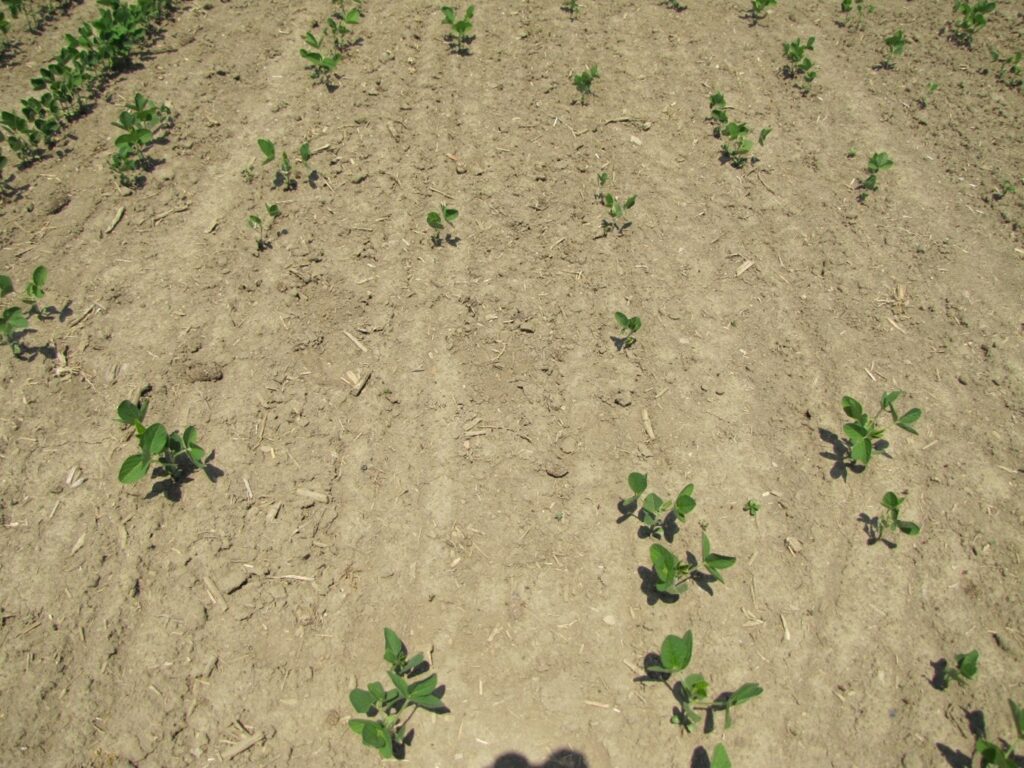Placement
Ontario trials have shown little benefit to banding P and K (5 cm (2 in.) to the side and 5 cm (2 in.) below the seed) compared to broadcast, See Table 1, Soybean Yield Response to Banded Fertilizer in Low-Testing Soils. Both broadcast and banded P and K blends added significant yield compared to the untreated check in these low soil testing trials. There is also no evidence that banding in a medium testing soil provides more yield than simply broadcasting the fertilizer, see table 2, Soybean Yield Response to Banded Fertilizer in Medium-Testing Soils.
Table 1. Soybean Yield Response to Banded Fertilizer in Low-Testing Soils
| Average soil test of 11 ppm for P and 92 ppm for K. All fertilizer was applied in the spring. Broadcast treatment was incorporated. Trials planted in 15” rows. A difference of less than 81 kg/ha (1.2 bu/acre) is statistically insignificant. 3 Ontario trials. | ||
| Treatment | Yield | Yield Advantage |
| Untreated | 3.05 t/ha (45.3 bu/acre) | – |
| 25P + 40K (broadcast) | 3.33 t/ha (49.5 bu/acre) | 0.28 t/ha (4.2 bu/acre) |
| 25P + 40K (2X2 band) | 3.35 t/ha (49.8 bu/acre) | 0.30 t/ha (4.5 bu/acre) |
Table 2. Soybean Yield Response to Banded Fertilizer in Medium-Testing Soils
| Average soil test of 18 ppm for P and 114 ppm for K. Broadcast treatment was incorporated. Trials planted in 15” rows. A difference of less than 81 kg/ha (1.2 bu/acre) is statistically insignificant. 9 Ontario trials. | ||
| Treatment | Yield | Yield Advantage |
| Untreated | 2.99 t/ha (44.4 bu/acre) | – |
| 25P + 40K (broadcast) | 3.05 t/ha (45.4 bu/acre) | 0.07 t/ha (1.0 bu/acre) |
| 25P + 40K (2X2 band) | 3.05 t/ha (45.3 bu/acre) | 0.06 t/ha (0.9 bu/acre) |
Timing
Both spring and fall application of fertilizer are acceptable from a soybean production perspective. There is no evidence that the application of potash or phosphorous in the fall prior to growing a soybean crop is more beneficial compared to spring application. The practice of “overfertilizing” corn to supply a subsequent soybean crop is also acceptable, as long as adequate nutrients are applied for both the corn and soybean crop, and proper management is taken to prevent nutrient loss between crops.
Safe Rates
Due to the reactivity to fertilizer salts, N and K fertilizer should not be placed in contact with soybean seeds. Unlike corn, there is no significant yield advantage to this practice. Severe plant stand reductions can occur if fertilizer is placed with the seed especially in dry years on sandy soils, see Figure 1, Reduced Stand due to Fertilizer Burn.

Figure 1. Reduced Stand due to Fertilizer Burn.
Instead, broadcast and incorporate the fertilizer into the soil in the fall or spring. A planter with a separate attachment for fertilizer placement may also be used to place the fertilizer 5 cm (2 in.) to the side and 5 cm (2 in.) below the seed. For further information, see Factsheet Maximum safe rates of nutrients. Due to the high percentage of chloride (45-47%) in muriate of potash (MOP) and its high salt index, the total amount of potash broadcast in the spring before a soybean crop should not exceed 340 kg/ha (300 lbs/ac).